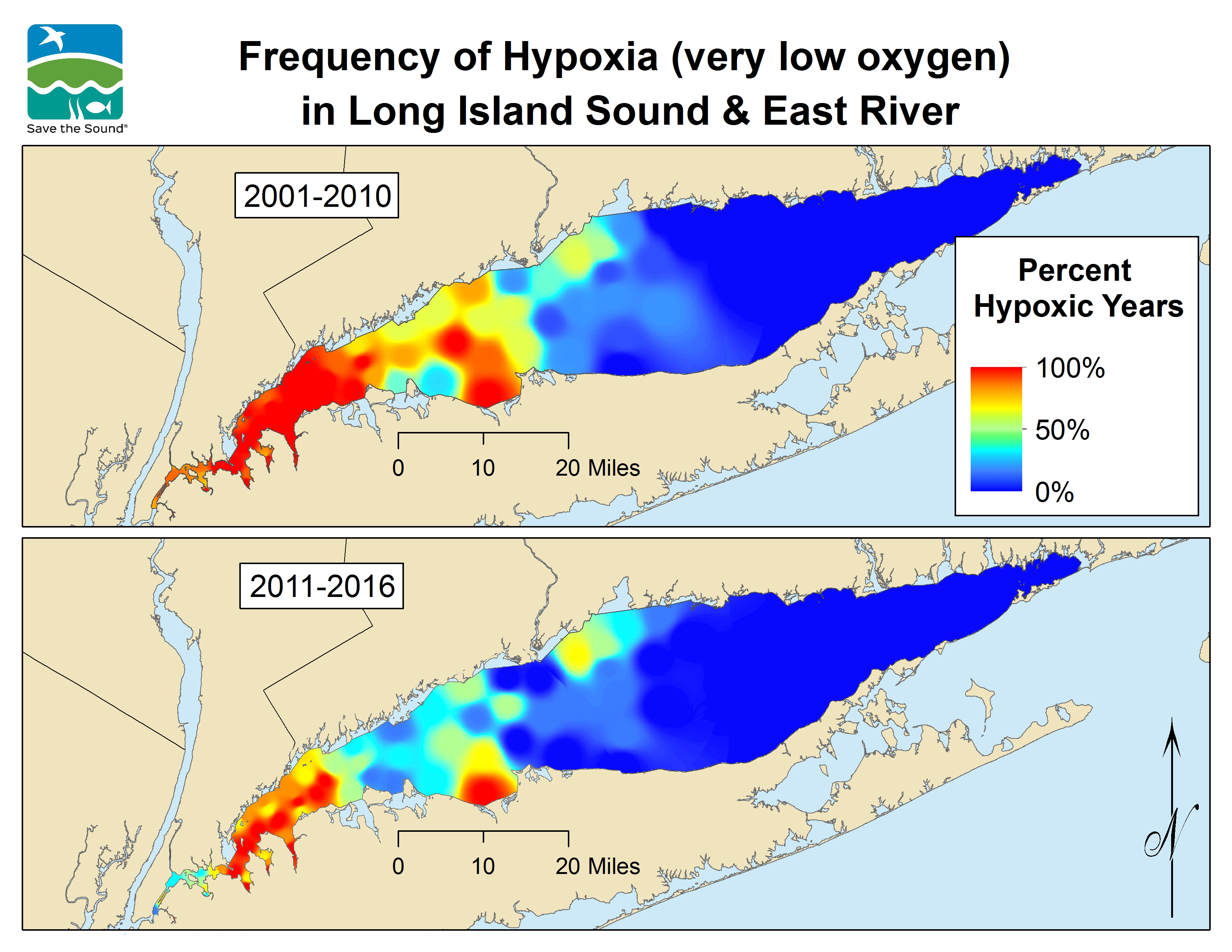November 15, 2017
HOW HEALTHY ARE NEW YORK AREA WATERS? SAVE THE SOUND RELEASES NITROGEN REPORT FOR EAST RIVER AND LONG ISLAND SOUND
NEW YORK, New York — The non-profit organization Save the Sound took to the steps of City Hall in New York City on November 15 to release their new study, “NYC Nitrogen Report: East River and Long Island Sound.” The landmark study, authored in collaboration with University of Connecticut Professor Jamie Vaudrey, examines the health of New York City-area waterways—the East River and Long Island Sound—where $1 billion has been invested to tackle nitrogen pollution. Excess nitrogen (often from treated sewage) depletes oxygen in the water and causes “dead zones” that lead to fish die-offs. High nitrogen levels also fuel toxic and nuisance algae blooms and deterioration of coastal marshes that protect shoreline communities from storm surges.
Watch live-recorded video from the press conference!
The report contained long-awaited good news, noting that investment in new sewage treatment technology by New York City at four East River facilities—completed earlier this year—appears to be shrinking dead zones in the East River and Long Island Sound. At the same time, the report calls for using the full capabilities of the new technology to continue to combat this threat which has been exacerbated by increasing population along the coast and impacts from climate change. The report shows that dead zones have not been eliminated and that, in fact, the East River and Long Island Sound dead zone in the summer of 2017 extended across approximately 95 square miles. The report found that the East River still contributes 18% of the nitrogen load reaching Long Island Sound and that a remarkable 98% of the nitrogen in the East River is from sewage discharge, even after treatment at wastewater facilities.
Tracy Brown, director of Save the Sound, commented, “New York City officials are to be applauded for reaching this important milestone. Investment in new sewage treatment technology—more than a decade in the making—has allowed the city achieve a 60% reduction in nitrogen discharge levels.” She added, “What this report shows, however, is that 60% doesn’t get us far enough. Fortunately, solutions are at hand that can further reduce discharge without requiring major capital investment—by ensuring the sewage plants maximize the use of this new technology. The report also clearly demonstrates the crucial but often-forgotten link between the East River and the Long Island Sound and their importance for New Yorkers.”

Both the East River and Long Island Sound are vital waterways for residents of New York City for a host of reasons including natural resources, tourism, and recreation. During the press conference, Save the Sound called on city officials to aim for an additional 10% reduction in nitrogen loads discharged to the East River versus 1990 levels, bringing the total reduction to 70%. Eliminating the low oxygen dead zones was the target of initial 58.5% nitrogen load reductions mandated by NYS Department of Environmental Conservation (NYSDEC) and CT Department of Energy and Environmental Protection (CTDEEP) under direction of the US Environmental Protection Agency (US EPA) in 2000.
Dr. Jamie Vaudrey, University of Connecticut, commented, “The NYC Nitrogen Report highlights a crucial recognition that has emerged in the decade and a half since initial target levels were established – which is the fact that climate change is impacting area waters and working counter to nitrogen load reductions. Higher ocean water temperatures coupled with greater acidity in the water accelerate the effect of nitrogen in fueling hypoxic zones, making nitrogen load reductions even more crucial.” Professor Vaudrey added, “What’s more, the East River area anticipates population growth of nearly 500,000 between 2010 and 2040, which will increase the demands placed on sewage treatment facilities.”
“The City’s rivers, streams, and creeks highlight how interconnected we truly are,” said Arturo Garcia-Costas, environment program officer at the New York Community Trust. “This report illustrates how nitrogen released into our precious waters in New York City affects the health and livelihoods of millions of peoples both inside and outside the five boroughs.”
Despite the challenges, Save the Sound representatives were upbeat about recent successes, and optimistic that an immediate opportunity exists to make further improvements in water quality. They pointed to Long Island Sound’s Orchard Beach in the Bronx, the most popular swimming beach in all of New York City, as an example of New Yorkers’ appreciation for the Sound and commitment to clean water.
###
About Save the Sound
Save the Sound is a bi-state program of the Connecticut Fund for the Environment with an established 45-year track record of restoring and protecting the waters and shorelines of the Long Island Sound. From its offices in Mamaroneck, NY and New Haven, CT, Save the Sound works for a cleaner, healthier, and more vibrant Long Island Sound where humans and marine life can prosper year-round. The organization’s success is based on scientific knowledge, legal expertise, and thousands of ordinary people teaming up to achieve results that benefit the environment for current and future generations. Learn more at www.savethesound.org.
Funding Provided by the New York Community Trust
Long Island Sound Funders Collaborative is a group of funders with missions that include protecting and restoring the Long Island Sound. www.lisfc.org.

1 thought on “Press Release: NYC Nitrogen Report, East River and Long Island Sound”
Comments are closed.